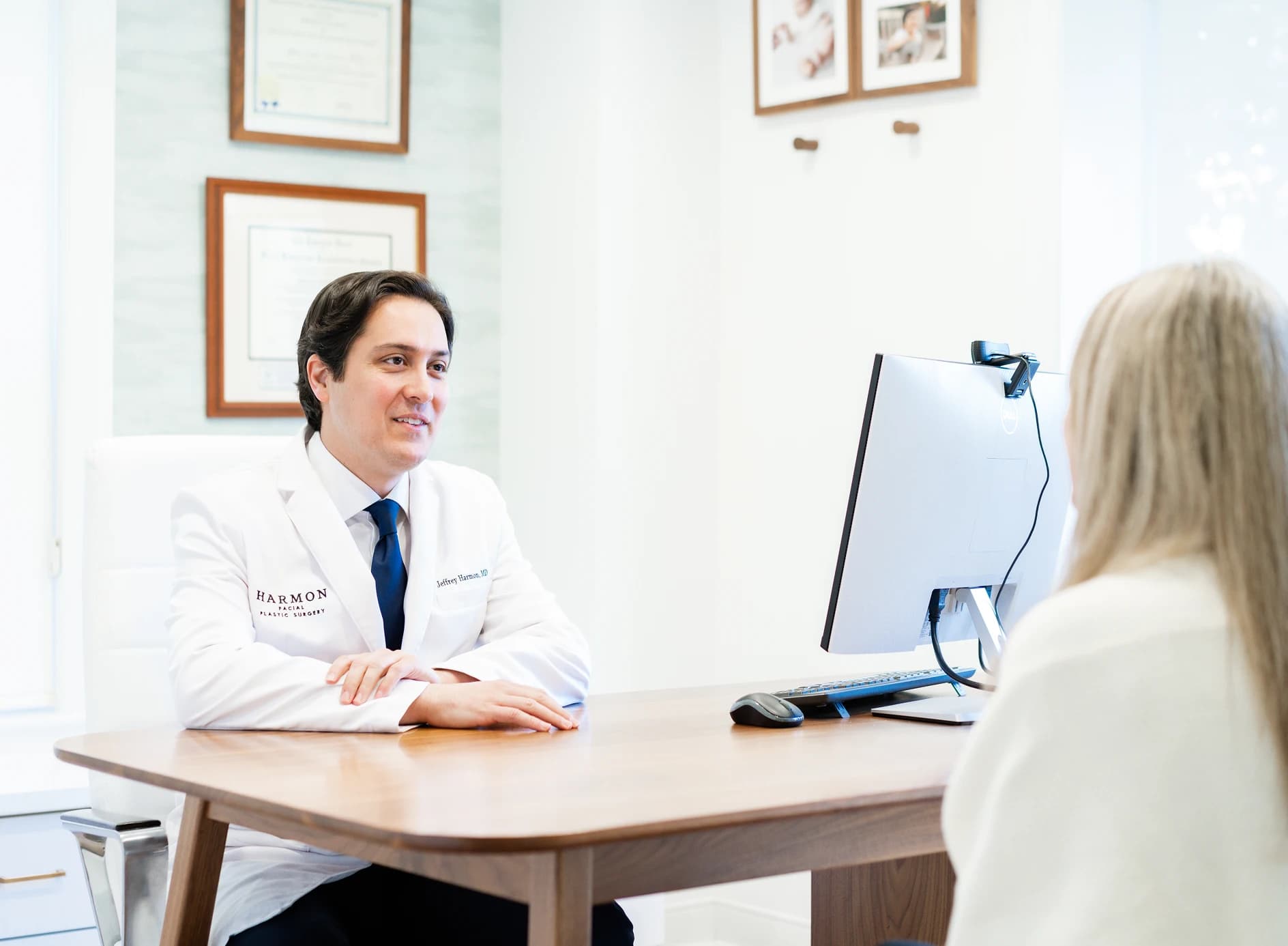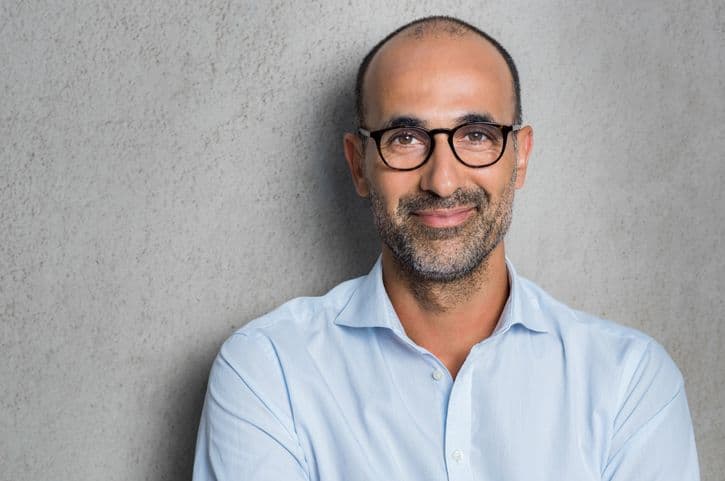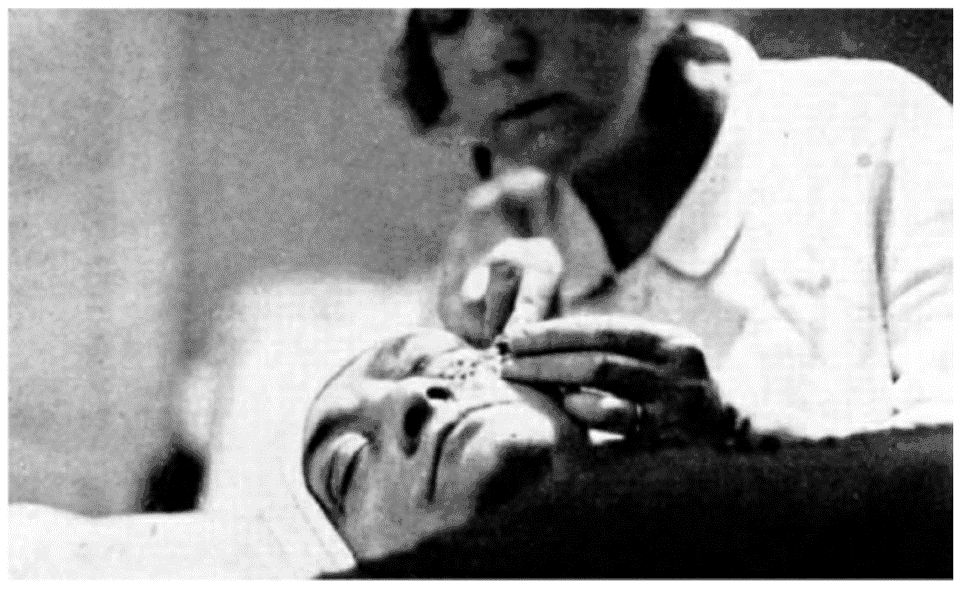Chin Implant
- Can be performed under local anesthesia only
- Small incision tucked discreetly under the chin
- More permanent treatment option when compared with dermal fillers
- Implants come in many shapes and sizes and can be further contoured prior to insertion
Contact Us
What is a Chin Implant?
A chin implant is a surgical procedure where a small incision is placed under the chin and a contoured implant is inserted along the jawline. The purpose of a chin implant is to improve the shape and projection of the chin. The implant is made from silicone, a non-reactive material that comes in many shapes and sizes. The implant itself can be further contoured prior to insertion.
What Conditions Does the Procedure Address?
A chin implant helps address a poorly projected chin that can appear flat and weak. A poorly projected chin makes the jawline appear short as well. A short jawline can make age-related changes in the neck more apparent. The conditions a chin implant can help address include:
Why Choose Dr. Harmon
The desire for youthfulness is understandable. There is no area more important than the face. After all, the face cannot be hidden. It is how we present ourselves to the world. Dr. Harmon works with a refined eye and trained hands to develop a personalized treatment plan with you, utilizing advanced techniques in surgical and non-surgical care of the face, nose, eyes, neck and hair.
Fellowship trained facial plastic surgeons have a unique specialized skill set in performing surgical and non-surgical procedures on the face, nose, eyes, neck and hair. The pathway to becoming a facial plastic surgeon begins with five years of rigorous training in head and neck surgery. This training is focused on all aspects of surgery for the head and neck, in addition to aesthetic and reconstructive procedures.
A small pool of top performing graduates from head and neck surgery programs are then selected to complete sub-specialty training as a fellow in facial plastic and reconstructive surgery through the American Academy of Facial Plastic and Reconstructive Surgery (AAFPRS).
Dr. Harmon completed his fellowship in facial plastic surgery through the AAFPRS with the world-renowned facial plastic surgeon Dr. Andrew Jacono on Park Avenue in New York City. Dr. Jacono is world renowned for developing the extended deep plane facelift technique. Dr. Harmon is one of the few surgeons in the world, and the only surgeon in the Cincinnati area, fellowship trained in this technique by Dr. Jacono.
Quad A Accredited Surgery Suite
Harmon Facial Plastic Surgery is proud to have a Quad A accredited operating room and facility in our office. Our single-physician, single-specialty facility meets or exceeds the strict guidelines and high standards set forth by Quad A, demonstrating our strong commitment to patient safety and excellence in surgical care. We utilize the services of board-certified anesthesiology physicians only as well as our own personal clinical support staff to ensure the most comfortable, safest experience for our clients.
Overview of the Procedure
The team at Harmon Facial Plastic Surgery works tirelessly to prepare patients well for their procedure. The time spent with patients and resources provided facilitates a smooth transition from the procedure through recovery. The following overview is a broad summary of the information provided to patients:
Procedure Consultation
Expect a detailed, informative discussion with Dr. Harmon about your concerns and aesthetic goals. He will develop a personalized treatment plan to address these concerns and goals.
Pre-Treatment Preparation
Patients receive a packet with detailed pre-operative instructions prior to surgery. This packet includes information on what supplements and medications to hold prior to surgery, activity restrictions, and what supplies are necessary for post-operative recovery. Prescriptions are sent prior to surgery with instructions on their use. Finally, if medical clearance is required, a form detailing the necessary clearance and testing is provided to present to their primary care provider.
Day of Treatment
Patients are instructed to arrive at the office in comfortable clothes. The surgical plan is discussed with the patient in detail. Paperwork is completed. Photos are usually taken pre-operatively. Finally, the patient meets the surgical team, which may include nurses, anesthesiologists, and/or scrub technologists, depending on the procedure(s) and type of anesthesia used. A loose-fitted dressing is applied and small drains are placed in the neck during surgery.
Follow-Up Appointment
Patients are instructed to apply cold compresses to the eyes for the first forty-eight (48) hours after surgery. Patients typically follow up for suture removal on day five (5) after surgery. Patients who undergo a chin implant are usually seen every two (2) weeks for the first six (6) weeks after surgery to monitor healing.
Social Readiness
Patients are generally permitted to wear makeup on the surgical site after all sutures are removed. The time to resolution of bruising and swelling varies and depends on multiple patient-specific factors. The incision can take months to heal completely, though they are tucked in natural creases and folds in the skin. However, many feel ready to socialize approximately seven (7) to fourteen (14) days after surgery.
Ideal Candidates for a Chin Implant
Ideal candidates for a chin implant include those patients who demonstrate:
- A poorly projected chin due to a flat jawbone
- Significant bony asymmetry in the chin
Most candidates for a chin implant range in age from their twenties (20s) to seventies (70s). A consultation is essential to determine candidacy for the procedure because there may be factors that preclude this procedure for certain individuals. Reasonable expectations must be established about what a chin implant can and cannot accomplish. As with all facial plastic surgery procedures, results can vary.
What to Expect from Recovery
Recovery from a chin implant is specific to the individual. The duration of recovery will vary from person to person.
Sutures are removed approximately seven (7) days after a chin implant. Typically, minial swelling and bruises are expected after a chin implant surgery.
Swelling generally improves significantly by seven (7) to ten (10) days after surgery.
The initial recovery time for a chin implant is approximately ten (10) to fourteen (14) days for most individuals. The healing process does not end after fourteen (14) days, however.
Swelling and bruises are expected to continue to improve and resolve in the ensuing days and weeks. The chin incision continues to heal for months after surgery.
Sutures are removed
Swelling is improved
Initial recovery time
Healing process continues
Benefits of a Chin Implant
The potential benefits of a chin implant include:
- Improved projection of a flat, weak chin
- Improved symmetry of a significantly asymmetric chin
- A de-emphasis of the severity of age-related changes to the neck when the jawline appears longer from the side
Risks of a Chin Implant
The potential risks of a chin implant include, but are not limited to:
- Bruising
- Swelling
- Infection
- Bleeding
- Nerve damage
- Abnormal scarring
- Asymmetry
- Movement of the implant
Combine a Chin Implant with Other Facial Enhancements
A chin implant complements other surgical and non-surgical procedures well. Procedures that complement a chin implant include, but are not limited to:
Deep plane facelift
Combining a chin implant with a deep plane facelift can support a comprehensive rejuvenation by strengthening the jawline and restoring youthful lift to the mid and lower face. This pairing can help enhance facial angles and structural definition.
Neck Lift
A neck lift helps refine the area beneath the chin, removing laxity and contour irregularities. When performed alongside a chin implant, it may improve the cervicomental angle (chin-throat angle), creating a more elegant and proportional side profile.
Brow lift
A chin implant and brow lift can work in tandem to balance the face's vertical thirds. Elevating the brow enhances expression and openness, while chin projection helps ground the overall aesthetic.
Blepharoplasty
Rejuvenating the eyes with blepharoplasty while enhancing lower facial projection with a chin implant can create harmony from top to bottom. This combination may refresh key focal points while supporting overall facial symmetry.
Rhinoplasty
Chin implants are often performed alongside rhinoplasty to help fine-tune profile aesthetics. By enhancing chin projection in relation to nasal contours, this combination may deliver a more refined and naturally proportioned appearance.
Fillers
Strategic use of fillers with a chin implant may create a more sculpted facial contour. Fillers can accentuate jawline angles or soften transitions, helping to refine and customize the overall result.
Botox©
Incorporating Botox© with a chin implant can subtly relax overactive muscles in the lower face. This can help prevent downward pull, maintain definition, and contribute to a more composed and balanced facial aesthetic.

Book Your Consultation
Take the first step toward your aesthetic goals with a personalized consultation. Dr. Harmon will listen to your concerns, answer your questions, and guide you through your options. Schedule your consultation today and discover how expert care can make a difference.
Read More About Chin Implants

Treatment Options for a Weak Chin
A weak, or recessed, chin can be concerning to men and women, not only because this feature can make the face appear smaller than it is, but it can...

What Facial Plastic Surgery Procedures Do Men Frequently Seek?
Men frequently seek a wide range of surgical and non-surgical facial plastic surgery procedures. This list is not all-inclusive but does highlight...

A History of Facial Plastic Surgery
This information is adapted from a presentation given to physician groups and a series of videos available online. It is important to seek not only a...
FAQ
What type of anesthesia is required?
Chin contouring implants can usually be placed under local anesthesia or IV sedation. Some individuals may require IV anesthesia.
Can chin contouring implants be placed with other procedures?
Yes. In fact, chin implants are commonly placed at the same time as nose surgery (rhinoplasty). This is because inadequate chin projection can cause the nose to appear larger than it actually is. A chin implant can create balance in the nose-chin relationship.
Does placement of a chin implant require a large incision?
No. A chin implant usually requires only a small – approximately 1.5 to 2 cm incision hidden under the chin.
Is placement of a chin implant a painful procedure?
Facial plastic surgery procedures are generally well-tolerated by patients and typically involve little pain, especially when compared with surgery on other areas of the body. Patients are usually prescribed just a small amount of pain medication for after surgery. In fact, we have found most use only over-the-counter pain medication including acetaminophen and/or ibuprofen after surgery instead. And those who do use the prescribed pain medication usually only use it the first night after surgery. With that in mind, it is important to note that every patient perceives and processes pain differently. Some patients have a high pain tolerance. Others may be more predisposed to be more sensitive to pain. We at Harmon Facial Plastic Surgery are focused on balancing minimizing post-operative discomfort and maximizing safety.
Are there different sizes and shapes to the implants?
Yes. There are many different sizes and shapes to the implants. The implant selected depends on a conversation with Dr. Harmon about your aesthetic goals and a detailed assessment of your anatomy.
How can a chin implant restore balance to my nose?
A "weak" or retruded chin can make the nose appear longer and larger than it actually is. A chin implant can improve the projection of the chin, reducing this effect. Then, a rhinoplasty can be performed with an improved understanding of its size and proportions.
What material are the implants made of?
Chin contouring implants are composed of silicone. Silicone is a good material for implants because it provides appropriate structure without tissue ingrowth into the material. As a result, the implants can be more easily removed and replaced if desire.
Can filler be added over chin implants?
Yes, filler can be added over these implants in the event that a patient desires some modifications beyond that which the implant provided. However, filler does dissolve over time. As a result, this is a temporary solution.
Written by Dr. Harmon
Discover the expertise and compassionate care of Dr. Jeff Harmon, a fellowship-trained facial plastic surgeon deeply rooted in the Cincinnati community. A former collegiate athlete and Cornell University graduate, Dr. Harmon brings discipline, precision, and a global perspective to his surgical practice—refined through elite fellowship training in New York City.
Located in Hyde Park, Harmon Facial Plastic Surgery proudly serves patients throughout the Cincinnati area offering personalized facial aesthetics with world-class skill and a hometown heart.